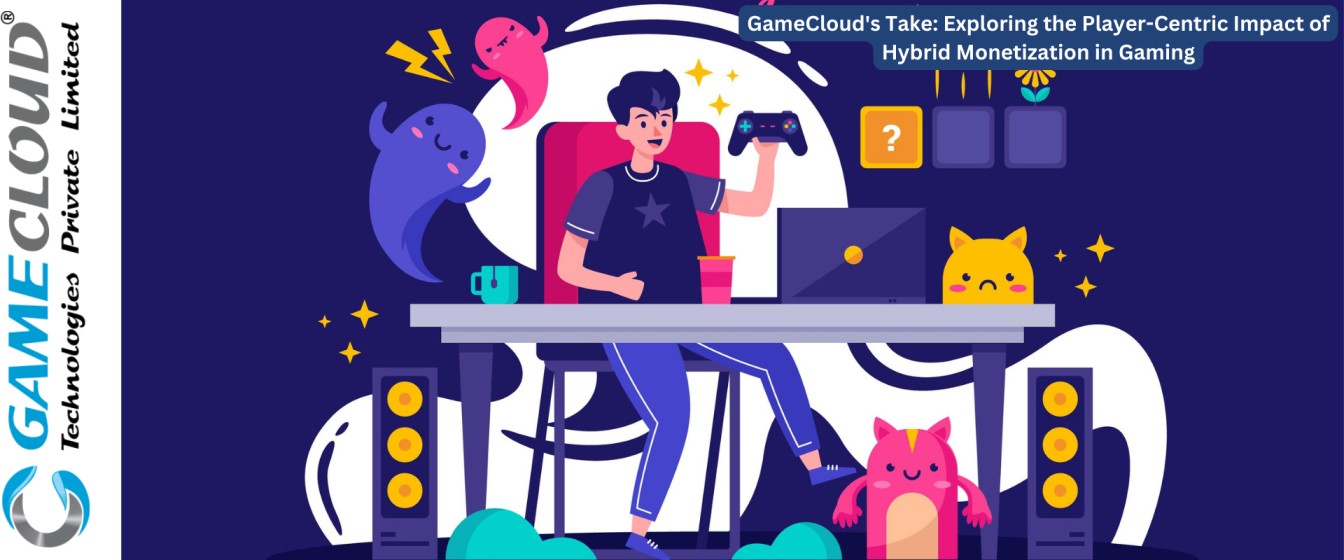
In the realm of gaming, where pixels and polygons reign supreme, a revolution is brewing. A revolution that’s not about graphics or gameplay, but about the very fabric of how we interact with our favorite pastimes. It’s a revolution that’s all about the player, and the ways in which we can make them feel seen, heard, and rewarded. This revolution is known as hybrid Monetization, and it’s changing the face of the gaming industry forever.
Imagine a world where you can play your favorite game without ever having to worry about running out of in-game currency. A world where you can access exclusive content, characters, and levels without ever having to part with your hard-earned cash. A world where the game adapts to your playing style, and rewards you for your dedication and skill. This is the world of it, where the boundaries between free-to-play and premium games are blurring, and the possibilities are endless.
But what exactly is hybrid Monetization, and how is it achieving this utopian vision? In this article, we’ll delve into the world of it, exploring its benefits, challenges, and future projections. We’ll examine the current trends and examples of it in action, and look at the ways in which it’s changing the gaming landscape. We’ll also explore the benefits and challenges of this approach, and examine the futuristic projections and predictions for the future of gaming.
So, buckle up, gamers, and get ready to enter a world where the player is truly at the center of the gaming universe. A world where the game is no longer just a game, but a living, breathing entity that adapts to your every move. A world where the possibilities are endless, and the fun is always just a click away.
The Rise of Hybrid Monetization
Hybrid Monetization has emerged as a transformative strategy in the gaming industry, revolutionizing the traditional revenue models and player engagement dynamics. This innovative approach involves integrating multiple Monetization methods within a single game, offering developers a more diversified and player-centric way to generate revenue. The rise of it can be attributed to several key factors that have reshaped the gaming landscape and propelled this strategy to the forefront of game development.
- Evolution of Player Preferences: One of the primary drivers behind the rise of hybrid Monetization is the evolving preferences of players. As gamers become more discerning and diverse in their gaming habits, developers have recognised the need to offer a variety of Monetization options to cater to different player segments. By combining in-app purchases, ads, and subscriptions, developers can create a more inclusive and engaging experience that resonates with a broader audience.
- Market Saturation and Competition: The gaming market has become increasingly saturated, with a plethora of games vying for players’ attention and spending. In this competitive landscape, developers are seeking innovative ways to stand out and monetise their games effectively. Hybrid Monetization provides a strategic advantage by offering a mix of revenue streams that can adapt to market fluctuations and player behavior, ensuring a more sustainable income model in the face of intense competition.
- Technological Advancements: Advancements in technology have played a pivotal role in driving the adoption of hybrid Monetization. Game engines like Unity and Unreal Engine have empowered developers to create more complex and engaging games with scalable Monetization features. Additionally, the integration of social features, live ops events, and multiplayer modes has enhanced player engagement and retention, making it a compelling choice for developers looking to maximize revenue and player satisfaction.

- Regulatory Changes and Privacy Concerns: The gaming industry has faced increasing scrutiny from regulators and privacy advocates, leading to stricter regulations around certain Monetization practices like loot boxes and intrusive ads. In response to these challenges, developers have turned to hybrid Monetization as a more sustainable and compliant revenue model. By diversifying their Monetization strategies, developers can navigate regulatory changes more effectively and ensure a steady revenue stream in a rapidly evolving regulatory landscape.
- Player-Centric Focus: At the core of the rise of hybrid Monetization is a player-centric approach that prioritizes the player experience and satisfaction. By offering a mix of in-app purchases, ads, and subscriptions, developers can tailor their Monetization strategies to meet the diverse needs and preferences of players. This player-centric focus not only enhances player engagement but also fosters a more sustainable and long-term relationship between developers and their audience.
The rise of hybrid Monetization represents a paradigm shift in the gaming industry, driven by changing player preferences, market dynamics, technological advancements, regulatory challenges, and a strong focus on player satisfaction. As developers continue to embrace this innovative strategy, it is poised to reshape the future of gaming, offering a more dynamic, inclusive, and player-centric approach to Monetization.
Benefits and Challenges of Hybrid Monetization
Benefits:
- Diversified Revenue Streams: Hybrid Monetization allows developers to create multiple revenue streams through a combination of in-app purchases, ads, subscriptions, and other models. This diversification reduces reliance on a single Monetization method and opens up additional income-generating opportunities.
- Flexibility and Adaptability: The hybrid approach provides developers with the flexibility to experiment, iterate, and optimize their Monetization strategies based on player feedback, behavior, preferences, and spending habits. This enables them to adapt to changing market conditions and player preferences.
- Catering to Different User Segments: Hybrid Monetization caters to a diverse player base by offering a range of Monetization options. This allows developers to target both players who prefer ad-supported free experiences and those willing to pay for premium features or content.
- Enhanced Player Engagement and Retention: By offering free access to engaging games and incentivising players with optional purchases, hybrid Monetization can enhance player engagement, retention, and lifetime value. This encourages continuous interaction, progression, and investment in the game ecosystem.
- Increased Accessibility and Reach: The freemium aspect of hybrid Monetization eliminates upfront costs, allowing developers to attract a larger user base and maximize user acquisition. This increased accessibility can lead to higher engagement and more opportunities for Monetization.

Challenges:
- Balancing Monetization and Player Experience: Developers must strike a delicate balance between implementing effective Monetization strategies and maintaining a positive player experience. Overly aggressive or intrusive Monetization tactics can alienate players and damage the game’s reputation.
- Transparency and Consent: Hybrid Monetization requires clear communication and transparency regarding in-app purchases, pricing, terms, conditions, and billing practices. Developers must ensure informed consent and compliance with regulations to build trust and mitigate risks.
- Complexity and Data Analysis: Implementing and optimizing a hybrid Monetization strategy involves complex data analysis, A/B testing, and the integration of various Monetization models. Developers must have the necessary expertise and infrastructure to effectively manage and analyze player data.
- Regulatory Compliance: Hybrid Monetization must adhere to evolving regulations, industry standards, and consumer protection laws related to in-app purchases, advertising, subscriptions, and data privacy. Maintaining compliance can be a significant challenge for developers.
- Maintaining Fairness and Inclusivity: Developers must design hybrid Monetization models with fairness, inclusivity, and accessibility in mind. Avoiding pay-to-win scenarios, unfair advantages, or barriers that may alienate players is crucial for maintaining a positive and engaging gaming experience.
Player-Centric Approach
The player-centric approach in gaming revolves around designing games and Monetization strategies that prioritize the player’s experience, preferences, and satisfaction. This approach is crucial in creating a more engaging, inclusive, and rewarding gaming environment that resonates with players across various demographics and gaming habits. The player-centric approach encompasses several key elements that are essential for developers to consider when designing games and implementing Monetization strategies.
- Fairness, Inclusivity, and Accessibility: A player-centric approach emphasizes fairness, inclusivity, and accessibility in game design and Monetization. By ensuring that all players have equal opportunities to enjoy the game and access its content, developers can create a more welcoming and engaging experience for a diverse player base. This approach involves removing entry barriers, such as upfront costs, and increasing accessibility for players across different demographics, geographies, and devices.
- Flexible Monetization Strategies: Player-centric design involves implementing flexible Monetization strategies that allow developers to experiment, iterate, and optimize based on player feedback, behavior, preferences, and spending habits. By offering freemium models that combine in-app purchases, ads, and subscriptions, developers can adapt their Monetization approach to maximize revenue potential while prioritizing player satisfaction.
- Player Engagement and Retention: A player-centric approach focuses on enhancing player engagement, retention, and lifetime value by offering free access to engaging games and incentivising players with optional purchases. By encouraging continuous interaction, progression, and investment in the game ecosystem, developers can foster long-term relationships with players and create a more immersive gaming experience.
- Diversified Revenue Streams: Developers adopting a player-centric approach leverage diversified revenue streams through advertising, sponsorships, partnerships, and collaborations. By combining multiple Monetization channels, developers can optimize revenue generation, mitigate risks, and achieve financial sustainability while catering to different player preferences and spending habits.
- Considerations and Best Practices: In a player-centric design, developers prioritize user experience by integrating ads seamlessly, ensuring relevance, and avoiding intrusive or disruptive placements that detract from gameplay immersion. Transparency, privacy compliance, and obtaining user consent are also crucial aspects of player-centric design, ensuring that players are informed about in-app purchases, pricing, terms, conditions, and billing practices.

In essence, the player-centric approach in gaming is about putting the player at the center of game development and Monetization strategies, creating a more personalized, engaging, and rewarding experience that resonates with players and fosters long-term relationships. By focusing on fairness, inclusivity, flexibility, engagement, and best practices, developers can cultivate a player-centric ecosystem that benefits both players and developers alike.
Player-Centric Impact of Hybrid Monetization in Gaming
The player-centric impact of hybrid Monetization in gaming has been exemplified by various real-life examples and current trends that showcase the evolution and significance of this approach in the gaming landscape.
Real-Life Examples:
- “Fortnite” by Epic Games: Fortnite has successfully implemented a player-centric approach to hybrid Monetization by offering a free-to-play model with in-game purchases for cosmetic items, battle passes, and limited-time events. This strategy has not only attracted a massive player base but also generated substantial revenue through optional purchases that enhance the player experience without affecting gameplay balance.
- “Genshin Impact” by miHoYo: Genshin Impact utilizes a hybrid Monetization model that combines in-app purchases for premium currency, gacha mechanics for character acquisition, and a free-to-play open-world experience. This approach has resonated with players, allowing them to enjoy the game for free while providing opportunities for spending on desired content and characters.
Current Trends:
- Personalized Offers and Rewards: Game developers are increasingly focusing on personalized offers and rewards tailored to individual player preferences and behaviors. By analyzing player data and engagement patterns, developers can offer targeted in-game promotions, discounts, and rewards that enhance the player experience and encourage spending.
- Live Events and Limited-Time Content: Live events and limited-time content have become popular trends in hybrid Monetization, creating a sense of urgency and exclusivity for players. Games like “Call of Duty: Warzone” and “Apex Legends” regularly introduce time-limited modes, challenges, and rewards that drive player engagement and Monetization through in-game purchases and battle passes.
- Cross-Platform Monetization: With the rise of cross-platform gaming, developers are exploring new opportunities for hybrid Monetization across multiple devices and platforms. Games like “Minecraft” and “Among Us” have successfully implemented cross-platform Monetization strategies that allow players to make purchases and progress seamlessly across different devices, maximizing revenue potential and player engagement.
Current Landscape:
The current gaming landscape is characterized by a growing emphasis on player-centric hybrid Monetization strategies that prioritize player satisfaction, engagement, and choice. Developers are increasingly adopting a mix of in-app purchases, ads, subscriptions, and limited-time events to create a more dynamic and rewarding gaming experience. The shift towards personalized offers, live events, and cross-platform Monetization reflects a trend towards a more inclusive and player-driven approach to Monetization in gaming.
Futuristic Projections and Predictions
As the gaming industry continues to evolve, the future of hybrid Monetization is poised to be shaped by emerging trends and technologies that will further enhance the player-centric approach. Experts predict that the coming years will witness a significant transformation in the way games are monetised, catering to the ever-changing preferences and expectations of players.
One of the key futuristic projections is the rise of non-fungible tokens (NFTs) and blockchain technology in the gaming ecosystem. The integration of NFTs is expected to create new opportunities for Monetization, allowing players to own and trade in-game assets, characters, and virtual items. This shift towards blockchain-based economies within games will empower players, giving them a greater sense of ownership and control over their digital possessions. Developers can leverage this trend to create more engaging and rewarding experiences, where players can actively participate in the game’s economy and potentially generate revenue through their in-game activities.
Another emerging trend that is expected to shape the future of it is the increasing focus on privacy and data protection. As players become more aware of the importance of their personal data and privacy, developers will need to adapt their Monetization strategies to be more transparent and user-friendly. This may involve the adoption of privacy-preserving technologies, such as differential privacy and homomorphic encryption, to ensure that player data is protected while still enabling effective Monetization strategies.
Furthermore, the integration of advanced analytics and machine learning algorithms will play a crucial role in the future of it. Developers will be able to leverage data-driven insights to personalize the player experience, optimize in-app purchases, and dynamically adjust their Monetization strategies based on individual player behavior and preferences. This level of personalisation and adaptability will be essential in creating a truly player-centric gaming ecosystem, where each player’s unique needs and preferences are catered to.
Additionally, the rise of cloud gaming and the proliferation of cross-platform gaming experiences will open up new avenues for it. Players will be able to seamlessly access and engage with games across multiple devices, allowing developers to offer a more unified and consistent Monetization experience. This cross-platform integration will enable players to make purchases, access content, and progress their gameplay across different platforms, further enhancing the player-centric approach.
As the gaming industry continues to evolve, the future of it will be characterized by a heightened focus on player-centricity, innovative technologies, and a deep understanding of player preferences and behaviors. Developers who embrace these trends and adapt their Monetization strategies accordingly will be well-positioned to create engaging, rewarding, and sustainable gaming experiences that cater to the diverse needs of the player base.
GameCloud’s Take on Exploring the Player-Centric Impact of Hybrid Monetization in Gaming
At GameCloud Technologies Pvt Ltd, the company’s primary focus is on providing video game QA testing and other outsource services that cater to the needs of game developers and publishers. Approach of Gamecloud to explore the player-centric impact of hybrid Monetization in gaming is centered around understanding the end-users’ likes and dislikes through their network of game testers. This approach allows game developers to test their games in unpredictable real-world conditions, providing valuable insights into player behavior and preferences.
The team of GameCloud Technologies is known for professionalism, responsiveness, and excellent communication skills, which are essential for building strong relationships with clients. The test team here is experienced in documenting issues and emphasizing bug quality over quantity, ensuring that game developers receive accurate and actionable feedback. By working closely with game developers, GameCloud helps them to refine their games and Monetization strategies to better meet the needs of their target audience.
Conclusion
And so, as we start the journey into the world of hybrid Monetization, we’re left with a sense of excitement and anticipation. The future of gaming is bright, and it’s clear that it is going to play a major role in shaping it. With its ability to adapt to player behavior, offer a wide range of Monetization options, and create a more personalized experience, it is the key to unlocking a new era of gaming.
But, as we look to the future, we must also acknowledge the challenges that lie ahead. The need for rigorous A/B testing, data science, and a robust analytics infrastructure is greater than ever. The pressure to stay ahead of the curve, to innovate and adapt, is intense. And yet, the rewards are well worth the effort.
For in the world of it, the player is truly at the center of the universe. They are the ones who drive the game forward, who shape its direction, and who make it the best it can be. And it’s this focus on the player, this commitment to creating a more personalized and rewarding experience, that will ultimately define the success of it.
So, as we look to the future, we can’t help but feel a sense of optimism. The future of gaming is bright, and it’s clear that it is going to be a major part of it. With its ability to adapt, innovate, and reward, hybrid Monetization is the key to unlocking a new era of gaming. And as we embark on this journey, we can’t help but feel excited, and a little bit proud, to be a part of it.
